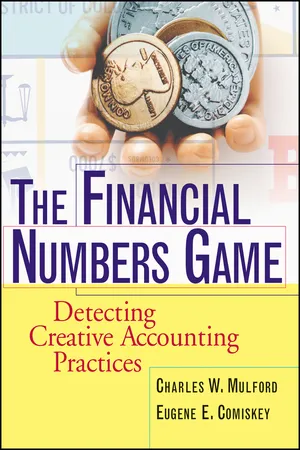
The Financial Numbers Game
Detecting Creative Accounting Practices
Charles W. Mulford, Eugene E. Comiskey
- English
- ePUB (apto para móviles)
- Disponible en iOS y Android
The Financial Numbers Game
Detecting Creative Accounting Practices
Charles W. Mulford, Eugene E. Comiskey
Información del libro
Praise for The Financial Numbers Game "So much for the notion 'those who can, do-those who can't, teach.' Mulford and Comiskey function successfully both as college professors and real-world financial mercenaries. These guys know their balance sheets. The Financial Numbers Game should serve as a survival manual for both serious individual investors and industry pros who study and act upon the interpretation of financial statements. This unique blend of battle-earned scholarship and quality writing is a must-read/must-have reference for serious financial statement analysis." --Bob Acker, Editor/Publisher, The Acker Letter "Wall Street's unforgiving attention to quarterly earnings presents ever increasing pressure on CFOs to manage earnings and expectations. The Financial Numbers Game provides a clear explanation of the ways in which management can stretch, bend, and break accounting rules to reach the desired bottom line. This arms the serious investor or financial analyst with the healthy skepticism required to drive beyond reported results to a clear understanding of a firm's true performance." --Mark Hurley, Managing Director, Training and Development, Global Corporate and Investment Banking, Bank of America "After reading The Financial Numbers Game, I feel as though I've taken a master's level course in financial statement analysis. Mulford and Comiskey's latest book should be required reading for anyone who is serious about fundamentally analyzing stocks." --Harry Domash, San Francisco Chronicle investing columnist and investment newsletter publisher
Preguntas frecuentes
CHAPTER ONE
Financial Numbers Game
I’d like to talk to you about another widespread, but too little-challenged custom: earnings management. This process has evolved over the years into what can best be characterized as a game among market participants. A game that, if not addressed soon, will have adverse consequences …1
Sybase’s shares dropped an additional 20% when the company reported improper practices at the Japanese subsidiary, which Sybase said included booking revenue for purported sales that were accompanied by side letters allowing customers to return software later without penalty.2Bausch & Lomb oversupplied distributors with contact lenses and sunglasses at the end of 1993 through an aggressive marketing plan…. The company said yesterday that in the fourth quarter of 1993 it “inappropriately recorded as sales” some of the product it sent to distributors.3Nine West Group Inc. said its revenue-booking practices and policies are under investigation by the Securities and Exchange Commission. The company’s shares plunged 18% on the news.4MicroStrategy Inc., the high-flying software company… announced it would significantly reduce its reported revenue and earnings for the past two years. … Shares of Micro-Strategy plummeted 62%, slicing about $11 billion off its market value.5In a long-awaited restatement, Sunbeam Corp. slashed its reported earnings for 1997 by 65%…. Sunbeam said the robust profit reported for 1997 resulted largely from an overly large restructuring charge in 1996, premature booking of revenue, and a variety of other accounting moves that have been reversed.6California Micro Devices Corp., a highflying chip maker, disclosed that it was writing off half of its accounts receivable, mostly because of product returns. Its stock plunged 40% after the announcement on August 4, 1994, and shareholders filed suit alleging financial shenanigans.7Waste Management Inc., undoing years of aggressive and tangled accounting, took $3.54 billion of pretax charges and write-downs, and said more conservative bookkeeping going forward would significantly crimp its earnings.8The once-highflying stock of Cendant Corp. plunged 46.5%, knocking $14 billion off the company’s market value, after the marketing and franchising concern said accounting problems would require it to reduce last year’s earnings and would hurt this year’s results.9Aurora Foods Inc.’s chief executive and three other top officers resigned as the company disclosed an investigation into its accounting practices that it said could entirely wipe out 1999 profit.10Baker Hughes Inc. said it discovered accounting problems at a business unit that will result in pretax charges of $40 million to $50 million, a disclosure that sent its stock falling 15% and revived Wall Street’s questions about the company’s performance.11
REWARDS OF THE GAME
Share Price Effects
| Label | Definitiona |
| Aggressive accounting | A forceful and intentional choice and application of accounting principles done in an effort to achieve desired results, typically higher current earnings, whether the practices followed are in accordance with GAAP or not |
| Earnings management | The active manipulation of earnings toward a predetermined target, which may be set by management, a forecast made by analysts, or an amount that is consistent with a smoother, more sustainable earnings stream |
| Income smoothing | A form of earnings management designed to remove peaks and valleys from a normal earnings series, including steps to reduce and “store” profits during good years for use during slower years |
| Fraudulent financial reporting | Intentional misstatements or omissions of amounts or disclosures in financial statements, done to deceive financial statement users, that are determined to be fraudulent by an administrative, civil, or criminal proceeding |
| Creative accounting practices | Any and all steps used to play the financial numbers game, including the aggressive choice and application of accounting principles, fraudulent financial reporting, and any steps taken toward earnings management or income smoothing |
| Category | Rewards |
| Share-price effects | Higher share prices Reduced share-price volatility Increased corporate valuation Lower cost of equity capital Increased value of... |